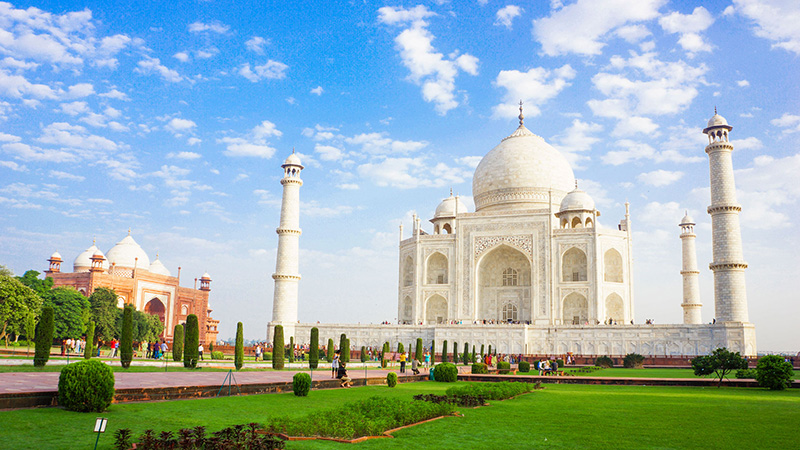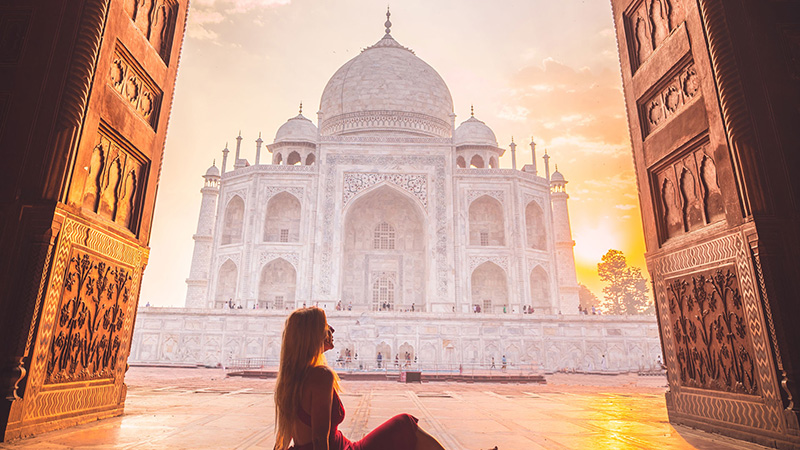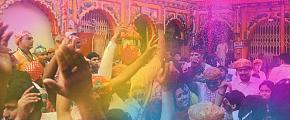Agra Travel Guide: Best Time, Top Attractions, Food, FAQ
Agra, a must-see destination during a tour to India, is known for its abundant historical heritage. It is home to one of the 7 wonders of the world, the Taj Mahal, which is also a UNESCO World Heritage Site. Agra is also included on the Golden Triangle tourist circuit, a well-traveled route providing a good spectrum of the country's different landscapes. Here is a complete guide presented to travelers who want to explore Agra.
Best Time to Visit Agra
The city features mild winters, hot and dry summers, and summer monsoons. The best time to visit Agra is in the winter season between November to March when the weather is pleasant and perfect for sightseeing. During this period, temperatures can range from 15°C to 34°C; the fog is also at its lowest, so you can appreciate the elaborately decorated architecture better. The Taj Mahotsav Event also happens in February. The 10-day carnival is held to commemorate the Mughal era of the 18th and 19th centuries CE. Around 400 Indian artisans display their works of art at the Taj Mahotsav.

Top 5 Attractions in Agra
Taj Mahal
The Taj Mahal, a UNESCO World Heritage Site, is the crown jewel of all the country's monuments. It's described by legendary poet Rabindranath Tagore as a "teardrop on the face of eternity" This 17th-century structure is a symbol of royal beauty and architectural paradise. The Taj Mahal is representative of Indian, Persian, and Islamic architectural styles. Mumtaz Mahal's grand mausoleum is richly decorated with jalli work, marble, and semi-precious stones sourced from all over the world. Millions of people visit this monument each year, and you should visit and appreciate its beauty as well.
 Taj Mahal
Taj Mahal
Agra Fort
Near the Taj Mahal's gardens is the important 16th-century Mughal monument known as the Red Fort of Agra, which is also a UNESCO World Heritage Site. Agra Fort is made entirely of red sandstone and is located on the right bank of the River Yamuna. Within its 2.5-kilometer-long enclosure walls, this powerful fortress contains the imperial city of the Mughal rulers. It contains many fairy-tale palaces, such as Shah Jahan's Jahangir Palace and the Khas Mahal, audience halls, such as the Diwan-i-Khas, and two very beautiful mosques. The view of the Yamuna River and the Taj Mahal from the fort's pavilions is also breathtaking.
 Agra Fort
Agra Fort
Sheesh Mahal
Built between 1631 and 1640 AD, Sheesh Mahal is famous for its extra thick walls, which were designed to keep the interiors cool and pleasant. Sheesh Mahal is also known as the "Palace of Mirrors" and "Hall of Mirrors." It is a marvel of precious stones and glass, as well as beautifully hand-crafted paintings. When illuminated, the mirrors would give the entire palace a sparkling effect. The walls and ceiling of the hall are adorned with exquisite artwork and flowers made of pure glass and valuable stone. And the placement of the ceiling glass is superb. As a result, if two candles are lit, the reflection transforms that dim light into thousands of stars.
Itimad-ud-daulah's Tomb
The Tomb of Itimad-ud-daulah is a Mughal mausoleum in the Indian city of Agra, Uttar Pradesh. Widely regarded as a draft of the Taj Mahal, it is sometimes referred to as the "Bachcha Taj" or the "Baby Taj". The structure includes numerous outbuildings and gardens in addition to the main building. The tomb, constructed between 1622 and 1628, represents a transition from the first phase of monumental Mughal architecture, which was primarily constructed of red sandstone with marble decorations, to the second phase, based on white marble and pietra dura inlay, which was most elegantly realized in the Taj Mahal.
Dayal Bagh
Amidst the busy city life of Agra, there stands a tranquil site, renowned as Dayal Bagh. Dayal Bagh's never-ending construction has been ongoing since 1904, guided by the belief that construction should always be currently in progress. The memorial is constructed entirely of pure white marble, with numerous pillars and fine pietra dura inlay work on the inner walls. Dayal Bagh is now one of the spiritual places in Agra where the inhabitants live in a healthy, disciplined, and cooperative manner in accordance with the ideals of their faith.
What to Eat in Agra?
Petha
If anything compares to the popularity of Agra's Taj Mahal, it is the delicious and popular Agra Petha, a popular Indian sweet from the state. It is translucent in appearance, soft, chewy, and candy-like, and can be eaten dry or dipped in sugar syrup (chashni). Petha is made from ash gourd vegetables, which are also known as winter melon or white pumpkin. It has a rectangular or cylindrical shape and is popular with both children and adults.
Bedai
Bedai is a typical deep-fried snack in India, usually served at street stands, and may be prepared sweet or savory, depending on the area. Bedai is fried puffy bread, served with a spicy green sabzi dotted with chunks of potato and a dollop of curd. To make the dish, a piece of dough is filled with spice and a mixture of ground urad dal, then deep-fried to produce a crispy and flavorful Bedai. This dish can be served as a snack or for breakfast with other dishes.
Paratha
The paratha has its roots in the Indian subcontinent and is a delicious flatbread typically made from wheat or flour. Being a staple of Indian cuisine, parathas are made and enjoyed in nearly every household and restaurant.
This unleavened traditional Indian flatbread is filled with tender and crisp layers. In his book, A Historical Dictionary of Indian Food, renowned food author Late K.T Achaya described paratha as "Wheat dough rolled out, with frequent folding over while smearing with fat, to a square or triangular shape, and pan fried using a little fat to a layered structure. Cauliflowers, potatoes, spinach, and methi leaves can be mixed into dough before frying."
Jalebi
Bright orange coils, shining with syrup, jalebi is among the most popular sweets in India. Jalebi is ribbons of flour dough that have been fried and soaked in sugar syrup, flavored with saffron and cardamom, and often colored orange with food coloring. Jalebi is popular not only for its taste but also for its historical significance. They are a favorite snack for both everyday and special occasions, such as Holi, Diwali, and Eid, because they are chewy, juicy, and crispy all at the same time. It is served as a breakfast food in some parts of India, but it is mostly eaten as a dessert. It can be eaten alone or dipped in yogurt or milk.
Most Asked Questions
1. What is the best time of day to visit the Taj Mahal?
Sunrise is the best time to visit the Taj Mahal because there are fewer people. If you go early in the morning, you can see the orange light reflecting off the surface of the monument, which makes for great photos. If you want to have the Taj Mahal to yourself, arrive at the East or West Gate half an hour before sunrise to get your tickets before a long line forms.
Sunset is also a beautiful time to visit but is more crowded than sunrise. Sunset turns the Taj Mahal a soft yellow and pinkish color and if you wait until dusk you'll see the marble turn shades of purple and blue.
 Taj Mahal
Taj Mahal
2. How much time does it take to reach Agra from Delhi and Jaipur respectively?
There are 4 ways to get from Delhi to Agra by train, bus, taxi, or car. The train journey time between Delhi and Agra is around 1h 50m and covers a distance of around 195 km. Operated by Indian Railways, the Delhi to Agra train service departs from New Delhi and arrives in Agra Cantt. If you choose to drive, then it will take about 2.5 hours, which is the same as by taxi. It takes 3.5 hours if you decide to take a bus.
There are 3 ways to get from Jaipur to Agra by train, taxi, or car. The train journey time between Jaipur and Agra is around 4h 5m and covers a distance of around 240 km. Operated by Indian Railways, the Jaipur to Agra train service departs from Jaipur and arrives in Agra Fort. If you want to drive or take a taxi, it will take approximately 3.5 hours.
3. Is it safe to visit Agra?
Agra, as a well-traveled city, is generally a safe city to visit as long as tourists follow certain safety precautions and behave responsibly. Agra has a low level of crime and is considered safe for tourists. However, it is best not to walk around the city alone at night, and it is also best not to show off cash or expensive items.
4. What to wear when visiting Agra?
During Summer
During the summer, the weather becomes dusty and sandy and UV rays are at their peak. It is strongly advised to apply a sunscreen lotion with a minimum SPF of 30. You can dress comfortably in T-shirts or thin long-sleeved shirts, and breathable trousers. Women can protect themselves from dust and scorching heat by carrying a scarf that covers their shoulders, head, and other exposed areas.
During Winter
During the winter months, temperatures usually range from 15°C to 34°C, and you will be comfortable wearing trousers and long-sleeved shirts during the day and may need a sweater or jacket at night. Always keep moisturizer handy, as the dry and cold air may affect your skin, especially your lips.
During Rainy Season
Having an extra set of clothes is a good idea during the rainy season. Wearing water-resistant clothing, such as jeans, is another option for staying dry in light rain. However, raincoats or umbrellas should always be carried in case of heavy rain. Waterproof footwear is also required. Avoid white and light shades as they may get mud stains.
5. What are the tips for taking photos in the Taj Mahal?
Arrive Early
Photographing the Taj Mahal at sunrise without crowds is an opportunity you should not pass up. The white mausoleum, bathed in the glory of the morning sun, is a visual delight. So plan your shoot the day before. The Taj Mahal, like most other heritage sites in India, opens at sunrise and closes at sunset. Check the sunrise time the day before and arrive at the ticket counter at least 30 minutes before sunrise.
Zoom in For the Details
Remember to bring a zoom lens if you want to shoot fantastic pictures. The architecture, as well as the scrollwork and stones, have a lot of detail that you won't want to miss in your photographs.
Explore Taj Mahal Photography in Moonlight
The tall shadows of the minarets and the large radiant dome against the moonlight are spectacular. Make a note of the next full moon and plan a nighttime visit to this magnificent mausoleum.
 Taking photos of Taj Mahal
Taking photos of Taj Mahal
Travel with Odynovo
Agra is a renowned tourist destination as it is home to one of the 7 wonders of the world, the Taj Mahal. History, culture, and architecture altogether create the wonder of Agra and make it a must-visit for anyone visiting India. Contact us if you are planning to explore those fascinating attractions and we will help you create a tailor-made trip that suits your travel style and interests.
Related Posts You May Like
What Our Clients Say
Explore the latest verified reviews of Odynovo's travel services on Tripadvisor, Google, Trustpilot, Product Review and more trusted platforms.













